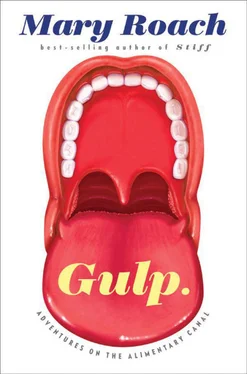The noxious-rectal-gas taboo in mainstream advertising has proved stronger and more lasting than that of condoms and even vibrators, which now turn up in brazenly suggestive ads on cable television (though still under the century-old euphemism “massager”). Mihalopoulos told me the editors of a CNBC feature on quirky businesses refused to air a segment about Parthenon, the family-run business that makes Devrom. “People don’t like to hear flatulence ,” he said, quickly adding that he meant the word. Or anyway, people think people don’t.
Given the obvious strength of the taboo, I wondered who had posed for the Devrom ad. How much do you have to pay people to appear in a full-page ad in a national magazine, talking about their smelly flatulence?
“Oh, I’d be shocked if someone would be willing to pose in an ad we’d run,” Mihalopoulos said. “It’s a stock photo.” Meaning anyone, for a fee, can run the image for whatever purpose they choose. The couple probably have no idea. Think twice before you sign a model release form. [92] Back in the 1980s when everyone looked a bit off, my friend Tim and his brothers had some publicity shots taken of their band. Eventually the photographer sold the rights to a stock photo agency. Years later, one of the images turned up on a greeting card. The inside said, “Greetings from the Dork Club.”
Most Devrom customers are people with extenuating digestive circumstances. They’ve had their stomachs stapled or bypassed to shed weight, or they’ve had all or most of a diseased gut removed and they’re excreting into an ostomy pouch. Mihalopoulos explained that, depending on how high up the opening is, the pouch may need to be emptied every few hours. Less time in the colon means less water is absorbed. The runnier the waste, the more surface area is exposed to the air and the more volatiles escape to reach the nose. “If you were to use the restroom at the airport, say…” Mihalopoulos paused to figure out where he was going with this. “You could tell right off that someone was emptying their pouch.”
It seemed, then, that we were not even talking about passing gas. “No, that too,” said Mihalopoulos. He explained that some people with an ostomy pouch will open a corner of it to let a little gas out. “It’s like Tupperware.” [93] Before you try to tell me that the proper verb for degassing Tupperware is burp not fart , let me pass along the words of a Tupperware spokeswoman I interviewed in 1998: “We don’t say burp anymore. Now we talk about making the seal ‘whisper.’” I don’t think whisper is a good substitute for burp , but it makes a lovely, poetic euphemism for the silent rectal passage. Forsooth, Horatio, even her whispers beguile me.
Mihalopoulos didn’t have data he could share regarding the number of people who were taking Devrom to defang garden-variety flatus odor, rather than because of a medical situation. I’m guessing there aren’t very many of them, and I think I know why. I think I know what’s keeping internal deodorant from charging ahead as a mainstream product. I’m going to let Beano inventor Alan Kligerman tell you what it is. “When I talk to people,” he told me, “when I really get them down to the nitty-gritty, I don’t know anybody, really, in their heart of hearts, who has any objection to the smell of their own.” And, unlike bad breath or stinky feet, “smelly flatulence” is everyone’s problem. [94] Though some more than others, depending on your flora. Some people have more of the sulfur -producing bacteria. The sulfur -spewers, by the way, prefer to colonize the descending colon, the part nearest the rectum. This is why noxious flatus tends to have heat. The composting happens right near the exit, so the flatus is, as gastroenterologist Mike Jones put it, “hot off the press.”
And thus really, no one’s.
As with the first bottle of Scope, the first bottle of Devrom, Mihalopoulos confirmed, is often left anonymously by a coworker or purchased by a spouse. “They themselves don’t object to it,” he said, “it” referring to the smell, not the purchase. Levitt said he is constantly approached at cocktail parties by women complaining about their husbands’ gas. He has never once heard a husband complain about a wife, despite this scientifically proven (by Levitt) fact: “the flatus of women has a significantly greater concentration of hydrogen sulfide and was deemed to have a significantly worse odour by both judges.” (However, this is likely balanced out by the male’s “greater volume of gas per passage.”)
The Devrom company is to be commended for not aggressively pushing internal deodorant on the public at large. Good for you, Jason Mihalopoulos, for not following in the springtime-fresh footsteps of douche marketers and, most recently, the Fleet enema company. [95] Inventors of the world’s first purgative superhero, EneMan: an enema bottle with arms and legs and a pointy nozzle head, dressed in a green cape. (Plush-toy EneMen occasionally turn up on eBay, not that I was looking.)
“Keep your backcountry clean,” says the Fleet Naturals ad copy, over an image of pristine mountain wilderness. “Created specifically for rectal cleansing… Mild enough for daily use.” Really? On top of gargling, on top of powdering our feet and perfuming our armpits, now we should worry that our assholes smell?
I later stumbled upon a “Tell Your Patients…” press release that Fleet had sent out to physicians. (One of them had posted it on his blog.) It turns out that Fleet Naturals is a product “for before or after anal intimacy.” Well okay then.
The simplest strategy for bouts of noxious flatus is to not care. Or perhaps to take the advice of a gastroenterologist I know: get a dog. (To blame.) Barring that, a person might try to steer clear of certain foods, [96] So strongly does stink depend on diet that the gases emanating from a rehydrated 6,400-year-old turd have been used to reconstruct the diet of an ancient “defecator.” Or so claimed J. G. Moore and colleagues in the 1984 article “Fecal Odorgrams.” The title refers to a method of analyzing waste fumes via a gas chromatograph and a “sniffing port.” Nowadays diet can be determined by sequencing the DNA of the food in fossilized turds, so no one need ever create (or send) a Fecal Odorgram.
the ones that provide bacteria with the raw materials for making sulfur compounds. The main offender is red meat. [97] Decomposing protein stinks: “aged” cheese, rotten eggs, corpses, dead skin on the bottoms of your feet. “Morning breath” is hydrogen sulfide released by bacteria consuming shed tongue cells while you mouth-breathe for eight hours; saliva normally washes the debris away. The stench is a warning: this item contains a lot of bacteria and could (depending on which bacteria they are) make you sick. The scariest, stinkiest cuisines are in countries where both food and refrigeration are scarce. Rural Sudanese eat fermented (that is, decomposing) caterpillar, frog, and, less proteinaceously, heifer urine. Yet one more reason tourism has been slow to catch on in the Sudan.
Cruciferous vegetables (broccoli, cabbage, brussels sprouts, cauliflower) can also kick up a stink. As can garlic, dried and sulfured fruit (for example, apricots), certain aromatic spices, and, for reasons unclear, beer. In short, so many delightful things that a sane person would, I like to think, rather have the gas.
• • •
ITRAVELED TO MINNESOTA with a fantasy that Michael Levitt might be able to whip up a batch of artificial flatus. I’m curious to see how close Science can get to Nature. Levitt smiles one of those placeholder smiles that buy you a moment to phrase your no. He elects to fob me off on his research partner Julie Furne, who has the ingredients downstairs in the lab. I recognize Furne’s name from the pantaloon studies. It turns out she had been one of the odor judges.
Читать дальше












